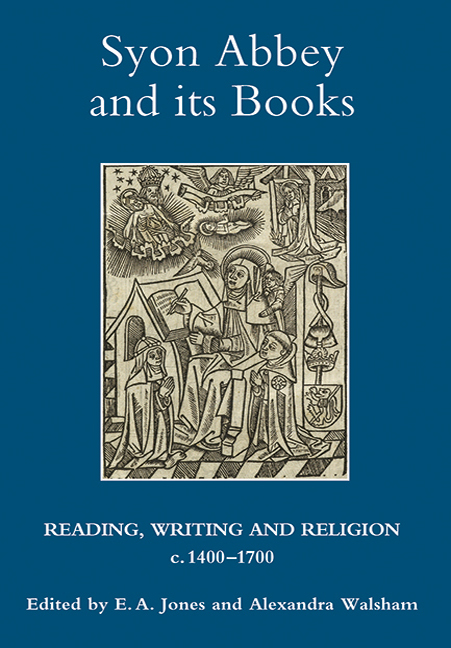Book contents
- Frontmatter
- Contents
- List of Illustrations
- Acknowledgments
- Notes on Contributors
- List of Abbreviations
- Syon Abbey: An Outline Chronology
- Introduction: Syon Abbey and its Books: Origins, Influences and Transitions
- I Brothers and Sisters
- II Syon Abbey and the Book Trade
- III The Bridgettines in Exile
- 5 Continuity and Isolation: The Bridgettines of Syon in the Sixteenth and Seventeenth Centuries
- 6 Books and Reading at Syon Abbey, Lisbon, in the Seventeenth Century
- IV History and Memory
- Appendix Syon Abbey's Books at the University of Exeter
- Index
- Miscellaneous Endmatter
6 - Books and Reading at Syon Abbey, Lisbon, in the Seventeenth Century
from III - The Bridgettines in Exile
Published online by Cambridge University Press: 09 May 2017
- Frontmatter
- Contents
- List of Illustrations
- Acknowledgments
- Notes on Contributors
- List of Abbreviations
- Syon Abbey: An Outline Chronology
- Introduction: Syon Abbey and its Books: Origins, Influences and Transitions
- I Brothers and Sisters
- II Syon Abbey and the Book Trade
- III The Bridgettines in Exile
- 5 Continuity and Isolation: The Bridgettines of Syon in the Sixteenth and Seventeenth Centuries
- 6 Books and Reading at Syon Abbey, Lisbon, in the Seventeenth Century
- IV History and Memory
- Appendix Syon Abbey's Books at the University of Exeter
- Index
- Miscellaneous Endmatter
Summary
St Bridget (c.1301–1373) placed study at the heart of her version of the monastic day when establishing her order and, as a result, from the time of its foundation by Henry V in 1415, books and learning were of central importance in the religious life at Syon Abbey. C. Annette Grisé, one of a number of historians who have discussed the importance of books at Syon, has described the convent as an important site of literary production and reception and a significant reading community. Syon nuns participated in the production of devotional and instructional manuscripts as readers, patrons and role models, although there is no surviving catalogue for the nuns to indicate what was in their library before their dissolution in 1539. Following the closure, the determination of a small group of Bridgettines to continue living as a community led them into a lengthy period spent largely in exile during which the maintenance of order and the performance of the liturgy were extraordinarily difficult. When they finally settled in Lisbon in 1594, the community entered a new period of stability which allowed them to rebuild their collection of books and revive the reading habits they had followed in England. This essay will focus on evidence of reading practices from the first hundred years in Lisbon and set the Bridgettines in the context of the new English foundations established in exile from 1598.
The Bridgettine community left accounts of the period following their dissolution which show that in spite of the considerable difficulties they experienced in Flanders they continued to perform divine office and follow the rule. There are several references to the problems of keeping religious observance going during these years, with the shortage of books and other deprivations: one observer wrote, ‘all their portable Bookes for theyr private use ar so rudely written, that it pytythe me to see them’. Ann Hutchison has found evidence that Abbess Katherine Palmer was actively seeking to improve the situation by commission or purchase: for instance, she had Henry of Herph's Directorium aureum contemplativorum recopied at Mishagen in Flanders. They had hoped that by moving to Rouen they would find a place where they could follow their religious practice in more secure surroundings. However, their hopes were misplaced.
- Type
- Chapter
- Information
- Syon Abbey and its BooksReading, Writing and Religion, c.1400-1700, pp. 177 - 202Publisher: Boydell & BrewerPrint publication year: 2010

